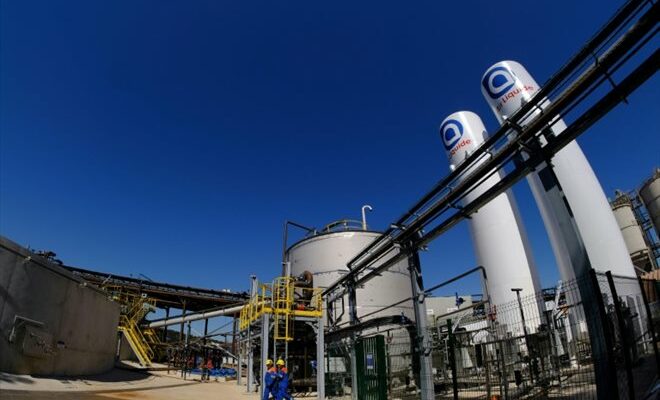The Alteo factory in Gardanne, March 22, 2019 in Bouches-du-Rhône (AFP/Archives/Boris HORVAT)
After discharging millions of tonnes of toxic “red sludge”, the Alteo plant in Gardanne (Bouches-du-Rhône), world leader in specialty alumina, would have continued to pollute the Calanques National Park with its liquid waste. , facts now earning him an indictment.
Four years after the opening of a judicial investigation for “endangering the lives of others”, the Marseille prosecutor’s office considered that sufficient evidence supported the arguments put forward for years by local residents and environmental associations, who denounced the pollution caused by the company.
The factory continued to discharge its effluent “by not respecting the assigned emission limit values”, the Marseille prosecutor’s office told AFP, confirming this indictment, dated October 17, revealed Friday by the daily newspaper Le Monde.
Alteo is suspected of having in Gardanne and Cassis between January 1, 2016 and December 31, 2021 “let flow into the waters of the sea within the limit of the territorial sea, directly or indirectly, one or more substances whose action or reactions have even temporarily led to harmful effects on health or damage to flora or fauna”, specified the Marseille prosecutor, Nicolas Bessone.
Several prefectural decrees authorizing the company to temporarily deviate from the toxicity thresholds for its liquid effluents at sea had however been taken in 2015, 2016, 2018 and 2020, in particular to safeguard several hundred jobs.
Despite this right to pollute, Alteo would therefore not have complied: its effluents discharged into the Mediterranean would still present too high concentration rates on one or more of the parameters targeted by the decrees, including heavy metals such as mercury and zinc. , lithium, copper or even arsenic.
According to Le Monde, these exceedances would have concerned mercury and arsenic in particular, with a total of 64 violations noted between 2016 and 2021.
In 2020, the company was however pleased to have achieved “its water quality objectives (…) by the deadline of August 30, 2020, in accordance with the prefectural decree”.
– Environmental scandal –
Under pressure from environmental associations and following a prefectural decree at the end of 2015, the factory had already had to stop dumping its solid waste of bauxite, the raw material for alumina, into the sea, nicknamed “red mud”. . In 50 years, the factory had released at least 20 million tons laden with arsenic and cadmium.
Since then, Alteo has only released liquid effluent, which is the reason for this indictment. Solid waste was stored outdoors in Bouc-Bel-Air, near Gardanne.
But nearly a dozen plaintiffs, including the mayor of the town of Gardanne, environmental associations and residents living near the factory, filed a complaint in 2018 for “endangering others”, citing a health and environmental scandal. . Their wish: to definitively stop all discharges from Alteo and condemn it for past pollution.
“Alteo has taken note of the indictment. Since its acquisition in 2021, the site has undergone a major industrial transformation, with the effective cessation of bauxite refining. In addition, we are actively continuing our efforts to reduce our environmental footprint” , told AFP the new president of the company, Alain Moscatello.
“We have inherited a liability and we are striving to do better, to do well,” he added.
After having long belonged to the French group Péchiney until 2003, Alteo has regularly changed owners since: bought by the Anglo-Australian mining giant Rio Tinto then by the American investment fund HIG in 2012, it has belonged since 2021 – after its placement in receivership due to a drop in orders and a crisis in the global aluminum market – to the United Mining Supply (UMS) logistics group based in Guinea.
Created in 1894, Alteo is the oldest alumina factory in the world. It imports its raw material mainly from Guinea to manufacture white alumina, used in arms, the automobile industry or the manufacture of mobile phones.
© 2024 AFP
Did you like this article ? Share it with your friends using the buttons below.




